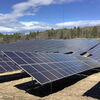Fed policy adviser: Three rate hikes possible in 2017
 Photo / Peter Van Allen
Jeffrey Fuhrer, executive vice president and senior policy adviser at the Federal Reserve Bank of Boston, delivers the keynote address at the Mainebiz "Five on the Future" forum in Portland today.
Photo / Peter Van Allen
Jeffrey Fuhrer, executive vice president and senior policy adviser at the Federal Reserve Bank of Boston, delivers the keynote address at the Mainebiz "Five on the Future" forum in Portland today.
Jeffrey Fuhrer, executive vice president and senior policy adviser at the Federal Reserve Bank of Boston, told more than 200 attendees at the Mainebiz “5 on the Future” forum in Portland today that the median view of the Fed’s policymakers is that there will be three 0.25 percentage point interest rate hikes in 2017 to ensure the U.S. economy’s growth continues at a sustainable rate.
If the Federal Reserve Board fulfills that prediction, it would represent a marked departure from the past decade, in which there were only two rate hikes, with the most recent being in mid-December when the Fed approved an interest rate hike of 0.25 percentage points (25 basis points) to a target range of 0.5% to 0.75%.
Fuhrer also forecast a 2% rate of growth in the Gross Domestic Product in 2017, which is consistent with the estimated 2% increase in the GDP seen in 2016. “Our forecast at this time last year was 2.2% growth, which is pretty close [to the estimated 2% GDP growth rate for 2016],” Fuhrer said.
Fuhrer said virtually all of that increase came from consumer spending, noting that other indicators of the country’s economic health show a slowing of job growth from an average of 200,000 new jobs per month nationally to 175,000 for the last three months of 2016. One factor in the leveling of the GDP growth rate at 2%, he said, is the decline in the growth of U.S. productivity, which had been showing an average improvement of 2% per year but is now at 0.5%.
“I was born a congenital optimist, so I will say that rate will probably not last forever,” he said of the lagging productivity rate.
Fuhrer foresees two economic factors that would significantly boost productivity: 1) An accelerated replacement of fossil-fuel energy sources with renewable energy sources, possibly in ways not even imagined at this time. “At some point, someone will invent a renewable non-fossil fuel energy source that will change the way the world operates,” he said. 2.) Improving the labor force participation rate, which continued its significant downward trend during the recovery from the recession.
Forecast for 2017
Looking ahead, Fuhrer said the incoming Trump administration has been “talking about things that could be fiscally stimulating” — such as tax cuts — but he tempered that by noting “trade restrictions could weaken growth … generally, they’re not helpful for a growing GDP. I do worry about trade restrictions.”
He also said restricting immigration could “weaken the growth of the labor force.”
He anticipates a 2% annual inflation rate will continue “for the next year or two.”
Turning his attention to Maine’s economy, Fuhrer said the state’s overall 4% unemployment rate is almost 1% better than the national rate. But there are significant pockets of chronic poverty and unemployment in Maine, he said, especially in communities that have seen local mills close during the past three years.
Just under 20% of Maine households are at or below the federal poverty level, he said, while the U.S. average is slightly more than 20%.
The challenge for Maine, he said, will be to “build the public-private” partnerships that will address the underlying causes of poverty and begin to rebuild economies that have been hit hard by the recent losses of major employers.










Comments